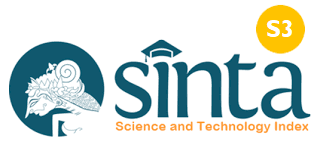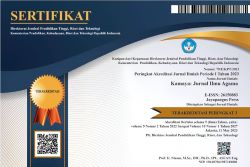Tebasan Penawa Sangga On Piodalan In Pura Luhur Pucak Padang Dawa Baturiti (Hindu Aesthetic Perspective)
Abstract
The implementation of yajña or rituals requires of various means called upakara, in the form of offerings (banten). Banten which is made as a symbol of God's manifestation (Bhatara) contains aesthetic elements, devotion, obedience, and sincerity. The Hindu community in Bali believes that by using upakara means they get closer to God and its manifestations being adored. Means of upakara include: daksina, peras, sesayut, tebasan, suci and other ayaban. One of the tebasan was named tebasan penawa sangga. Tebasan penawa sangga was dedicated to the piodalan in Pura Luhur Pucak Padang Dawa which contains a religious aesthetic element. Tebasan penawa sangga educated the public so that the public will learn about the meaning, meaning and function used in the implementation of piodalan in Pura Luhur Pucak Padang Dawa.
The theory used in this research were: (1) Religious theory, (2) Aesthetic theory, and (3) symbol theory. Sources of data used were primary data and secondary data. The method used to collect data was observation, interview, literature study, and document study. The data which had been collected were analyzed by using descriptive technique. The result of the research showed the aesthetic forms of the tebasan penawa sangga were: (1) the aesthetic form satyam, (2) the aesthetic shape siwam, (3) the aesthetic form sundaram. The functions of tebasan penawa sangga were: (1) The function of religious aesthetics, (2) The function of social aesthetics. The meanings of tebasan penawa sangga were: (1) the meaning of religious aesthetics, (2) the meaning of social aesthetics, 3) the meaning of aesthetics in education. As a final word, it was suggested to the leaders, figures of Hinduism and academics to provide guidance with the guidance and enlightenment regarding to the meaning of tebasan penawa sangga.
References
Adnyana. Minder. I Nyoman. 2012. Arti Fungsi Banten Sebgai Sarana Persembahyangan. Denpasar: Pustaka Bali Post.
Arikunto, Suharsimi. 2002. Prosedur Penelitian suatu Pendekatan Praktek (Edisi Revisi V). Jakarta: Rineka Cipta.
Arwati, Ni Made Sri. 2005. Bentuk, Fungsi dan Makna Upakara Dewa Yadnya.
Bagus, Lorens. 2005, Kamus Filsafat, PT.Gramedia Pustaka Umum. Jakarta
Black, James, Champion, Dean. 1999. Metode dan Masalah Penelitian Sosial. Jakarta: Refika Aditama.
Bungin, Burham (Ed.). 2004. Metode Penelitian Kualitatif. Aktualisasi Metodelogis ke Arah Ragam Varian Kontemporer. Jakarta: PT. Raja Grafindo Persada.
Dharmayudha, I Made Suasthawa dan I Wayan Korti Cantika. 1991. Filsafat Adat Bali. Denpasar. Upada Sastra.
Dibia, I Wayan. 2000. Taksu Dalam Seni Dan Kehidupan Bali. Denpasar: Bali Mangsi.
Dibia, I Wayan. 2000. Tari Wali Sanghyang, Rejang, Baris. Denpasar: Dinas Kebudayaan Propinsi Bali.
Djelantik, A.A.M. 2004. 2008. Pengantar Dasar Ilmu Estetika, Jilid IV, Falsafah Keindahan dan Kesenian, Sekolah Tinggi Seni Indonesia. Bandung.
Djelantik, A.A.M. 2004. Pengantar Dasar Ilmu Estetika, Jilid III, Falsafah Keindahan dan Kesenian, Sekolah Tinggi Seni Indonesia. Bandung.
Gie, The Liang. 2004. Filsafat Seni Sebuah Pengantar. Yogyakarta: Pusat Belajar Ilmu Berguna
Downloads
Published
How to Cite
Issue
Section
License
An author who publishes in the Kamaya : Jurnal Ilmu Agama agrees to the following terms:
- Author retains the copyright and grants the journal the right of first publication of the work simultaneously licensed under the Creative Commons Attribution-ShareAlike 4.0 License that allows others to share the work with an acknowledgement of the work's authorship and initial publication in this journal
- Author is able to enter into separate, additional contractual arrangements for the non-exclusive distribution of the journal's published version of the work (e.g., post it to an institutional repository or publish it in a book) with the acknowledgement of its initial publication in this journal.
- Author is permitted and encouraged to post his/her work online (e.g., in institutional repositories or on their website) prior to and during the submission process, as it can lead to productive exchanges, as well as earlier and greater citation of the published work (See The Effect of Open Access).
Read more about the Creative Commons Attribution-ShareAlike 4.0 Licence here: https://creativecommons.org/licenses/by-sa/4.0/.





